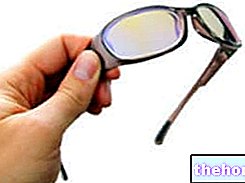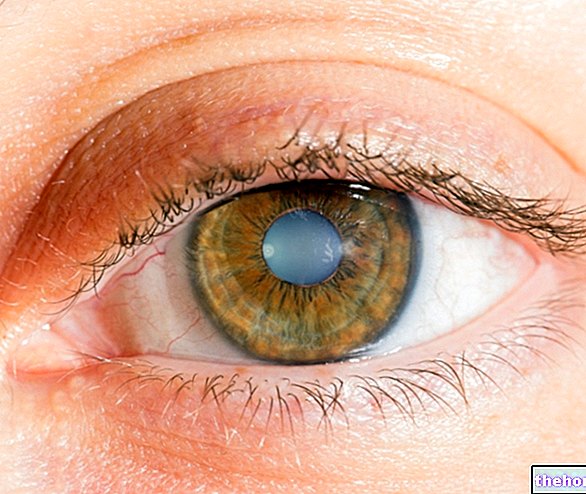The objective observation performed by the physician however remains essential both to ascertain a supposed allergic conjunctivitis and to identify the allergen involved in the allergic reaction.
Brief Review: Possible Causes of Allergic Conjunctivitis
Let us briefly recall that allergic-based conjunctivitis differs precisely on the basis of the causative agent (therefore the allergen that caused it): pollen, dust mites, the epithelium of domestic animals, or some substances contained in the lenses. in contact or in certain cosmetics, allergic reactions to the conjunctiva may originate in sensitive patients.
How is Allergic Conjunctivitis Diagnosed?
Diagnosis begins with a "careful eye examination supported by anamnesis, that is, by collecting information and symptoms reported by the patient. To complete the visit, the subject is normally subjected to more in-depth investigative tests, in order to accurately identify the allergen responsible for the allergic reaction. For this purpose, it is necessary to perform a series of tests in the laboratory:
- Prick-test: this diagnostic analysis involves the injection on the skin surface of a small amount of the substance thought to be responsible for allergic conjunctivitis. The possible appearance of an allergic skin reaction with redness, edema and itching constitutes a positive test.
- Tear fluid test: allows you to identify the presence of IgE (type E immunoglobulins) directed against a given allergen.
- Conjunctival provocation test: it is performed by putting the conjunctiva in contact with a very small amount of "suspicious" substance. When the patient is allergic to that substance, the symptoms of allergic conjunctivitis (eye redness, intense itching and eyelid swelling) appear suddenly or flare up.
Differential diagnosis
Although the diagnosis is quite simple, it is not uncommon for allergic conjunctivitis to be confused with a disease with related symptoms. To avoid making a mistake in the treatment, it is essential to ascertain the diagnosis and, where possible, to identify the responsible allergen.
The differential diagnosis must be made with:
- Viral conjunctivitis;
- Bacterial conjunctivitis;
- Uveitis;
- Acute glaucoma;
- Keratitis (inflammation of the cornea);
- Scleritis (inflammation of the sclera);
- Bacterial orbital cellulitis;
- Dry eye syndrome.
The therapy - exclusively of medical competence - makes use of the use of ophthalmic ointments / eye drops based on active antihistamines (to reduce itching) and / or corticosteroids (to exert a powerful anti-inflammatory action).
Antiallergic eye drops are, in fact, prepared with antihistamine active ingredients, such as, for example, tonzylamine or pheniramine.
For further information: Antihistamine eye dropsWhile not acting in any way on the triggering cause, corticosteroid-based anti-inflammatory eye drops are indispensable drugs for healing because they are capable of determining a powerful anti-inflammatory action in the eye, relieving symptoms such as swelling and redness in a short time.
In the presence of a particularly aggressive form of allergic conjunctivitis, a double therapy consisting in the joint use of eye drops (topical application) and drugs to be taken by mouth (oral route) is conceivable.
Did you know that ...
Antihistamine eye drops work by blocking the action of histamine, a powerful chemical mediator involved in allergic and inflammatory phenomena. By doing so, antihistamines prevent or relieve the symptoms of the allergic reaction.
When the symptoms of the allergic reaction are quite bearable, it is possible to resort, for a few days, to free sale products that combine active ingredients with a decongestant action and antihistamines.
Decongestant eye drops - which act by inducing a narrowing of the blood vessels of the conjunctiva - remove in a relatively short time the characteristic symptoms of allergic conjunctivitis, namely lacrimation, hyperemia (red eye) and swelling.
, pollinosis or hay fever. As we know, spring allergic conjunctivitis has a "seasonal incidence: in this regard, sensitive patients should undertake prophylactic therapy already during the first weeks of March through the moderate and regular application of antihistamine eye drops. In any case, the doctor will provide all the necessary information regarding any prophylactic therapies to be adopted.Allergic conjunctivitis induced by a "hypersensitivity to substances contained in cosmetics or contact lenses can be prevented by avoiding contact with these products: contact lenses can be replaced with eyeglasses, while the choice of make-up products it must be addressed exclusively to hypoallergenic ones. affected by allergic conjunctivitis:
- Always respect the instructions provided by the doctor and the dosage (dosage) indicated by him: excessive use of decongestant drugs, for example, can paradoxically cause the opposite effect, thus ending up worsening the symptoms of congestion.
- Despite being over-the-counter products, decongestant eye drops should be used with extreme caution by patients suffering from hyperthyroidism, hypertension, diabetes and heart disease. For this reason, the advice is to always consult your doctor before instilling any eye drops in the eye.
- To reduce conjunctival swelling and congestion, chamomile tea packs can be helpful in providing immediate relief. It is recommended to use a clean cotton ball for each compress.
- Protect your eyes with sunglasses with UV filters.
- Wash your hands thoroughly before touching your eyes.
- Don't scratch your eyes.
- Do not use eye drops that have expired or have been opened for more than 7 days in the case of multidose bottles or for more than 24 hours in the case of single-dose vials.
- Avoid wearing contact lenses during the entire duration of therapy for allergic conjunctivitis (unless otherwise directed by your doctor).
Other articles on "Conjunctivitis"
- Allergic Conjunctivitis: Causes and Symptoms
- Conjunctivitis
- Bacterial Conjunctivitis
- Viral conjunctivitis
- Viral conjunctivitis: diagnosis, treatment and prevention
- Conjunctivitis - Drugs for the treatment of Conjunctivitis




.jpg)























